Energy and Fuel Consumption of a New Concept of Hydro-Mechanical Tractor Transmission
Abstract
:1. Introduction
2. Materials and Methods
2.1. Powertrain
2.2. Modeling
2.2.1. Equations of Speed
2.2.2. Equations of Torque
2.2.3. Computation Model
2.3. Verification
3. Analysis and Discussion
3.1. Power Flow
3.2. Characteristics of Efficiency under Full Load
3.3. Characteristics of Efficiency under Partial Load
3.4. Characteristics of Fuel Consumption of “Engine–HMT” System
3.5. Comparison of Energy and Fuel Consumption of Two HMTs
3.6. Comparison of Fuel-Saving Performance of Two HMTs
3.7. Further Comparison with Target Efficiency Proposed by Renius
4. Conclusions
- The HMT had lower energy consumption at the rated engine speed, with efficiencies of 0–75%, 0–87%, and 75–89% in the ranges RY, RL, and RH, respectively, under a full load. Considering that the speed of the tractor once it had started was 4 km/h, the maximum portion of hydrostatic power of the HMT in each range was about 45–46%. When influenced by parasitic power, the efficiency of this HMT was higher when the displacement of the pump was positive than when it was negative. Reducing the engine speed and increasing the load-induced torque can both improve the efficiency of transmission of the HMT during operation. However, when the tractor moved at a low speed, an excessive load-induced torque could increase the loss of speed of the motor and reduce the efficiency of transmission of the HMT. Therefore, the hydrostatic power-split ranges of the HMT are not suitable for operation at extremely low speeds but can be used to start the tractor. This allows for the removal of the brake in the hydrostatic range to further simplify the structure of the transmission.
- The distribution of the fuel consumption of the system in the engine map was approximately consistent with that of the efficiency of the HMT, and both were centered around the optimal point of operation and expanded into nested rings. Therefore, the fuel consumption of the engine itself did not constrain the system’s fuel consumption, which caused the fuel economy of the tractor to be largely determined by the efficiency of transmission of the HMT.
- Compared with the Simpson HMT, the transmission examined here not only has a simpler structure and lower energy consumption but also has better fuel economy in most field operations. In this study, the fuel consumption of Standard HMT during plowing, harrowing, sowing, spraying, and field transportation is 0.8%, 1.4%, 16.5%, 3.3%, and 3.1% lower than that of Simpson HMT, respectively.
Author Contributions
Funding
Institutional Review Board Statement
Informed Consent Statement
Data Availability Statement
Conflicts of Interest
Nomenclature
| HMT | Hydro-mechanical transmission. | , | Coefficients of loss of energy of the pump shaft and the motor shaft due to friction, respectively. |
| Full load | The efficiency of transmission of the HMT when the torque of the input shaft reaches the external characteristic torque of the engine. | , | Torques of gear 1 and gear 2, respectively. [N·m] |
| Partial load | The efficiency of transmission of the HMT when the torque of the input shaft does not reach the external characteristic torque of the engine. | Efficiency of meshing of gear 1 and gear 2. | |
| Standard HMT | HMT with a single planetary gear. | , , | Torques of the sun gear, the ring gear, and the carrier, respectively. [N·m] |
| Simpson HMT | HMT with two single planetary gears. | Efficiency of transmission of the planetary gear. | |
| RY, RL, RH, RR | Ranges of the Standard planetary HMT. | , | Relative efficiencies of transmission of the sun gear and the planetary gears and of the ring gear and the planetary gears, respectively. |
| GL, GH | Mechanical gears of the Standard planetary HMT. | Speed of rotation of the planetary gears in the conversion mechanism. [r/min] | |
| HY, HM1–4 | Ranges of the Simpson planetary HMT. | Efficiency of transmission of the HMT. | |
| , | Theoretical flows of the pump and the motor, respectively. [L/min] | Output speed of the HMT. [r/min] | |
| , | Rated displacements of the pump and the motor, respectively. [m3/rad] | , | Torques of the engine and the output torque of the HMT, respectively. [N·m] |
| , | Speeds of rotation of the pump shaft and the motor shaft, respectively. [r/min] | , | Engine fuel consumption and system fuel consumption, respectively. [g/(kw·h)] |
| e | Ratio of displacement of the pump to that of the motor. | , | Portions of hydrostatic power of the HMT with and without parasitic power, respectively. |
| Leakage-induced flow of the hydraulic system. [L/min] | , , | Powers of the sun gear, the ring gear and the planet carrier, respectively. [kW] | |
| Total coefficient of leakage of hydraulic oil. | Traction resistance. [N] | ||
| Difference in pressure between the inlet and the outlet of the motor. [Pa] | Number of plowshares | ||
| Dynamic viscosity of hydraulic oil. [Pa·s] | , | The depth and the width of the plow, respectively. [cm] | |
| , | Speeds of rotation of gear 1 and gear 2. [r/min] | Soil-specific resistance of plowing. [N/cm2] | |
| Transmission ratio of gear 1 and gear 2. | Coefficient of utilization of traction. | ||
| , , | Speeds of rotation of the sun gear, the ring gear, and the carrier of the planetary gear set, respectively. [r/min] | , | The depth and the width of the harrow, respectively. [cm] |
| k | Standing ratio of the planetary gear set. | Soil-specific resistance of harrowing. [N/cm2] | |
| Transmission ratio of the tractor in the range (∈ {Y, L, H}). | Number of openers. | ||
| The gear pair gx (x = 1–6). | Working resistance of a single opener. [N] | ||
| Speed of the tractor. | Rolling resistance. [N] | ||
| Engine speed. [r/min] | , | Masses of the tractor and the agricultural machinery, respectively. [kg] | |
| Power radius of the driving wheel of the tractor. [m] | Ravitational acceleration. [m/s2] | ||
| Transmission ratio of the rear axle of the tractor. | Coefficient of rolling resistance. | ||
| , | Torques of the pump shaft and the motor shaft, respectively. [N·m] | Output power of the HMT. [kW] | |
| Coefficients of viscous damping of the pump shaft and the motor shaft, respectively. [N·m·s/rad] | Efficiency of the transmission of the rear axle. |
References
- Available online: https://data.stats.gov.cn (accessed on 30 May 2023).
- Han, J.Y.; Yan, X.X.; Tang, H. Method of controlling tillage depth for agricultural tractors considering engine load characteristics. Biosyst. Eng. 2023, 227, 95–106. [Google Scholar] [CrossRef]
- Ranjbarian, S.; Askari, M.; Jannatkhah, J. Performance of tractor and tillage implements in clay soil. J. Saudi Soc. Agric. Sci. 2017, 16, 154–162. [Google Scholar] [CrossRef] [Green Version]
- Buberger, J.; Kersten, A.; Kuder, M.; Eckerle, R.; Weyh, T.; Thiringer, T. Total CO2-equivalent life-cycle emissions from commercially available passenger cars. Renew. Sustain. Energy Rev. 2022, 159, 112158. [Google Scholar] [CrossRef]
- Edwards, R.; Hass, H.; Larivé, J.F.; Lonza, L.; Maas, H.; Rickeard, D. Well-to-Wheels Analysis of Future Automotive Fuels and Powertrains in the European Context; Technical Report by the Joint Research Centre of the European Commission; European Commission: Ispra, Italy, January 2014.
- Li, J.F.; Wu, X.H.; Zhang, X.M.; Song, Z.H.; Li, W.J. Design of distributed hybrid electric tractor based on axiomatic design and Extenics. Adv. Eng. Inform. 2022, 54, 101765. [Google Scholar] [CrossRef]
- Chen, Y.N.; Xie, B.; Du, Y.X.; Mao, E.R. Powertrain parameter matching and optimal design of dual-motor driven electric tractor. Int. J. Agric. Biol. Eng. 2019, 12, 33–41. [Google Scholar] [CrossRef] [Green Version]
- Chen, Y.C.; Chen, L.W.; Chang, M.Y. A design of an unmanned electric tractor platform. Agriculture 2022, 12, 112. [Google Scholar] [CrossRef]
- Zhang, Q.; Sun, D.Y.; Qin, D.T. Optimal parameters design method for power reflux hydro-mechanical transmission system. Proc. Inst. Mech. Eng. Part D 2019, 233, 585–594. [Google Scholar] [CrossRef]
- Xue, L.J.; Jiang, H.H.; Zhao, Y.H.; Wang, J.B.; Wang, G.M.; Xiao, M.H. Fault diagnosis of wet clutch control system of tractor hydrostatic power split continuously variable transmission. Comput. Electron. Agric. 2022, 194, 106778. [Google Scholar] [CrossRef]
- Yu, J.; Cao, Z.; Cheng, M.; Pan, R.Z. Hydro-mechanical power split transmissions: Progress evolution and future trends. Proc. Inst. Mech. Eng. Part D 2019, 233, 727–739. [Google Scholar] [CrossRef]
- Nilsson, T.; Fröberg, A.; Åslund, J. Fuel potential and prediction sensitivity of a power-split CVT in a wheel loader. In Proceedings of the 2012 Workshop on Engine and Powertrain Control, Simulation and Modeling, Rueil-Malmaison, France, 23–25 October 2012. [Google Scholar]
- Ince, E.; Guler, M.A. On the advantages of the new power-split infinitely variable transmission over conventional mechanical transmissions based on fuel consumption analysis. J. Clean. Prod. 2020, 244, 118795. [Google Scholar] [CrossRef]
- Rossetti, A.; Macor, A.; Benato, A. Impact of control strategies on the emissions in a city bus equipped with power-split transmission. Transp. Res. D Transp. Environ. 2017, 50, 357–371. [Google Scholar] [CrossRef]
- Wang, G.M.; Zhao, Y.H.; Song, Y.; Xue, L.J.; Chen, X.H. Optimizing the fuel economy of hydrostatic power-split system in continuously variable tractor transmission. Heliyon 2023, 9, e15915. [Google Scholar] [CrossRef]
- Rossetti, A.; Macor, A. Control strategies for a powertrain with hydromechanical transmission. Energy Procedia 2018, 148, 978–985. [Google Scholar] [CrossRef]
- Ahn, S.; Choi, J.; Kim, S.; Lee, J.; Choi, C.; Kim, H. Development of an integrated engine-hydro-mechanical transmission control algorithm for a tractor. Adv. Mech. Eng. 2015, 7, 1687814015593870. [Google Scholar] [CrossRef]
- Liu, H.X.; Han, L.; Cao, Y. Improving transmission efficiency and reducing energy consumption with automotive continuously variable transmission: A model prediction comprehensive optimization approach. Appl. Energy 2020, 274, 115303. [Google Scholar] [CrossRef]
- Mola, M.; Amani, A.M.; Jalili, M.; Khayyam, H. Data-Driven Predictive Control of CVT System for Improving Energy Efficiency of Autonomous Vehicles. IEEE Trans. Veh. Technol. 2023, 72, 1501–1514. [Google Scholar] [CrossRef]
- Fu, B.; Zhu, T.P.; Liu, J.G.; Zhao, Y.H.; Chen, J.W. Influencing Factors of Electric Vehicle Economy Based on Continuously Variable Transmission. Int. J. Automot. Technol. 2022, 23, 717–728. [Google Scholar] [CrossRef]
- Zhang, M.Z.; Wang, J.Z.; Wang, J.H.; Guo, Z.Z.; Guo, F.Q.; Xi, Z.Q.; Xu, J.J. Speed changing control strategy for improving tractor fuel economy. Trans. Chin. Soc. Agric. Eng. 2020, 36, 82–89. [Google Scholar] [CrossRef]
- Renius, K.T.; Resch, R. Continuously variable tractor transmissions. In Proceedings of the 2005 Agricultural Equipment Technology Conference, Louisville, KY, USA, 14–16 February 2005. [Google Scholar]
- Rossetti, A.; Macor, A. Multi-objective optimization of hydro-mechanical power split transmissions. Mech. Mach. Theory 2013, 62, 112–128. [Google Scholar] [CrossRef]
- Rossetti, A.; Macor, A.; Scamperle, M. Optimization of components and layouts of hydromechanical transmissions. Int. J. Fluid Power 2017, 18, 123–134. [Google Scholar] [CrossRef]
- Xia, Y.; Sun, D.Y.; Qin, D.T.; Zhou, X.Y. Optimisation of the power-cycle hydro-mechanical parameters in a continuously variable transmission designed for agricultural tractors. Biosyst. Eng. 2020, 193, 12–24. [Google Scholar] [CrossRef]
- Ince, E.; Güler, M.A. Design and analysis of a novel power-split infinitely variable power transmission system. J. Mech. Des. 2019, 141, 54501. [Google Scholar] [CrossRef]
- Nao, Z.G. Introduction to planetary gear transmission. In Design of Planetary Gear Transmission, 2nd ed.; Zhang, X.H., Yan, M., Eds.; Chemical Industry Press: Beijing, China, 2019. [Google Scholar]
- Wang, G.M.; Song, Y.; Wang, J.B.; Xiao, M.H.; Cao, Y.L.; Chen, W.Q.; Wang, J.X. Shift quality of tractors fitted with hydrostatic power split CVT during starting. Biosyst. Eng. 2020, 196, 183–201. [Google Scholar] [CrossRef]
- Liu, F.X.; Wu, W.; Hu, J.B.; Yuan, S.H. Design of multi-range hydro-mechanical transmission using modular method. Mech. Syst. Signal Process. 2019, 126, 1–20. [Google Scholar] [CrossRef]
- Chen, W.Q.; Xu, Z.Y.; Wu, Y.Q.; Zhao, Y.H.; Wang, G.M.; Xiao, M.H. Analysis of the shift quality of a hydrostatic power split continuously variable cotton picker. Mech. Sci. 2021, 12, 589–601. [Google Scholar] [CrossRef]
- Guo, Z.Z.; Yuan, S.H.; Jing, C.B.; Wei, C. Modeling and simulation of shifting process in hydraulic machinery stepless transmission based on AMESim. Trans. Chin. Soc. Agric. Eng. 2009, 25, 86–91. [Google Scholar] [CrossRef]
- Leitner, J.; Aitzetmüller, H.; Marzy, R. Das mechanisch-hydrostatisch leistungsverzweigte, stufenlose Fahrzeuggetriebe S-Matic. In Proceedings of the Congress Antriebstechnik Zahnradgetriebe, Dresden, Germany, 14–15 September 2000. [Google Scholar]
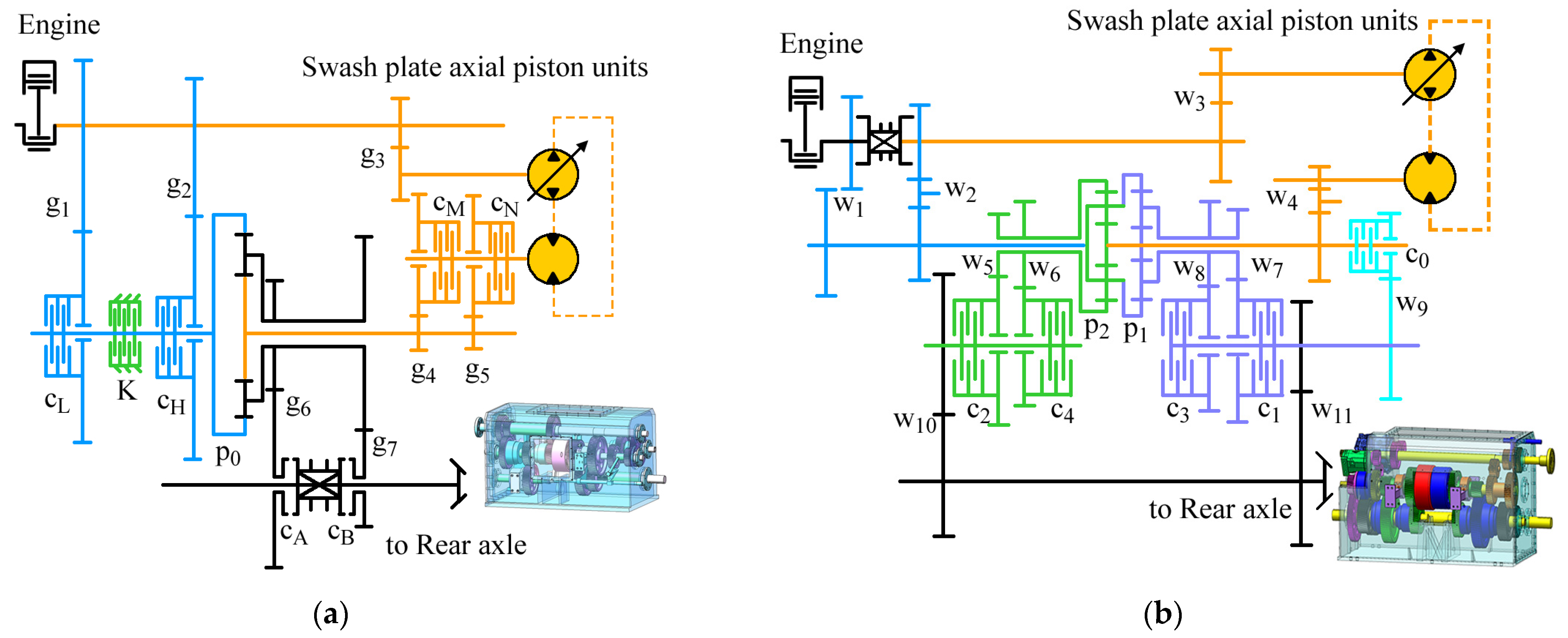
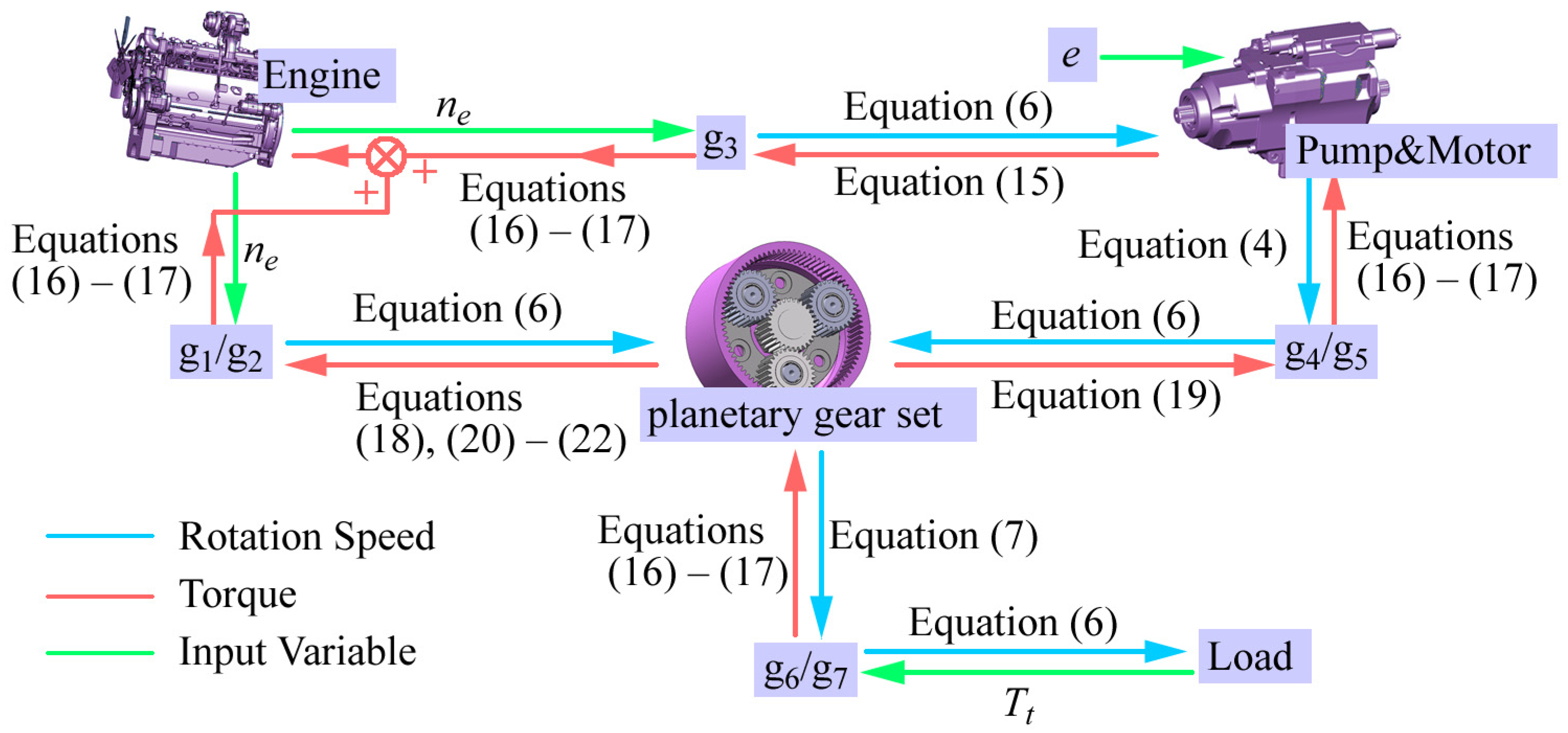
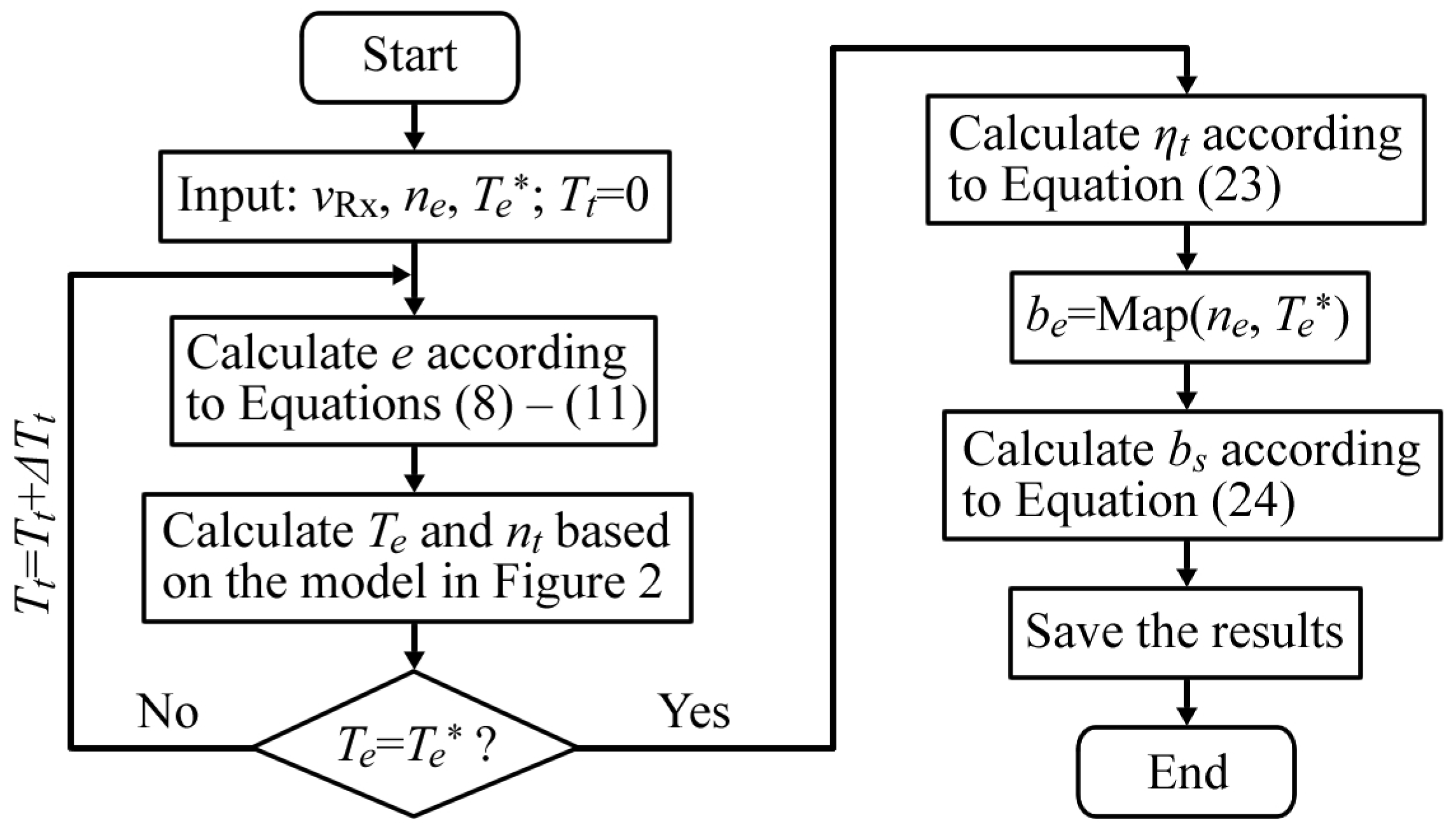
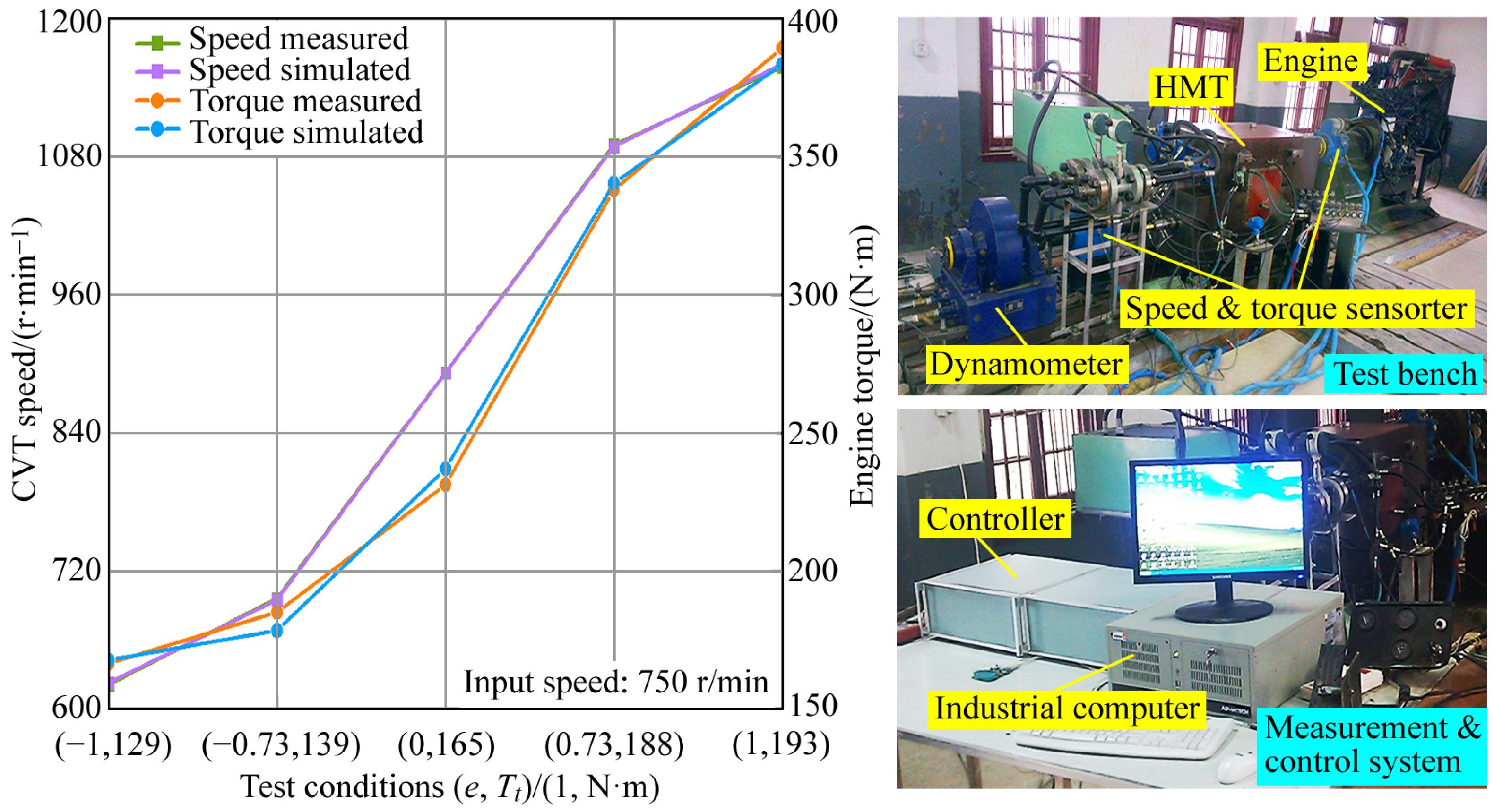
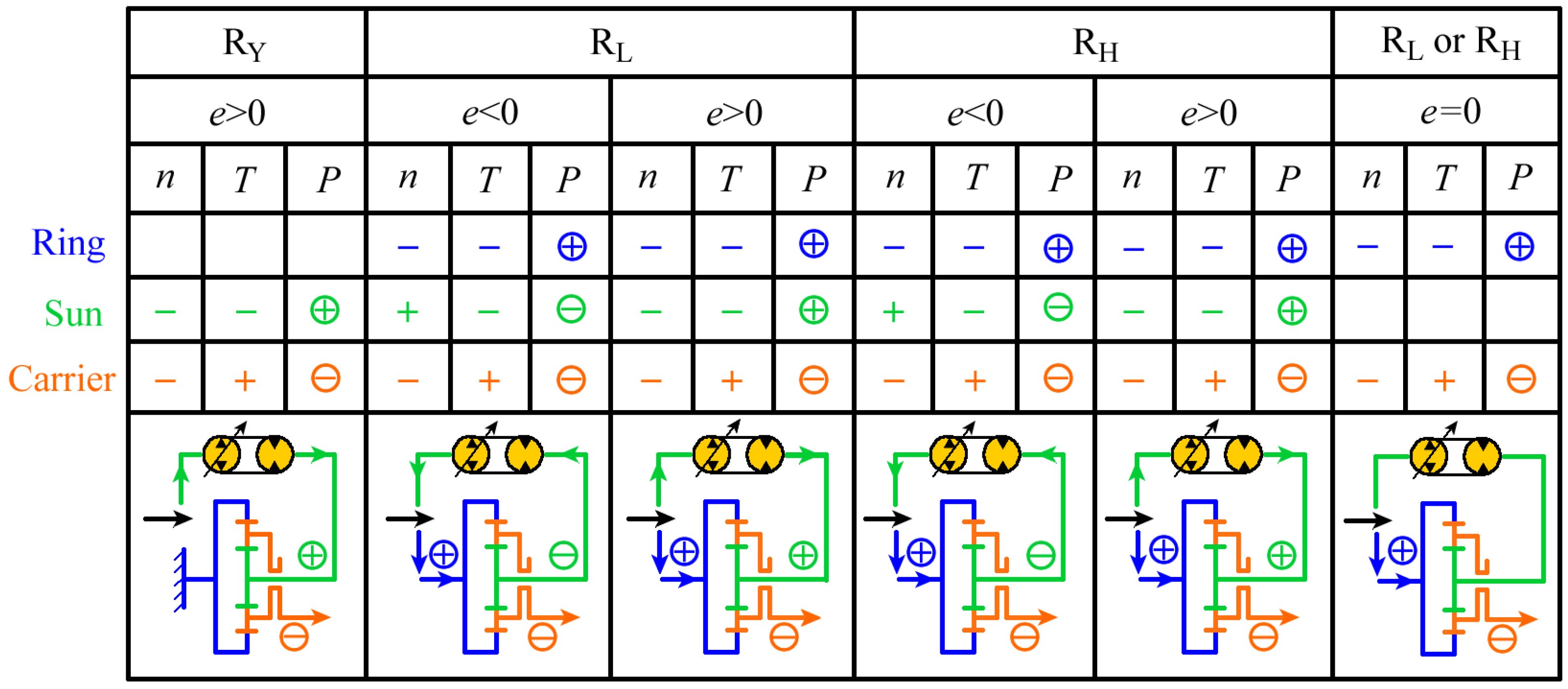


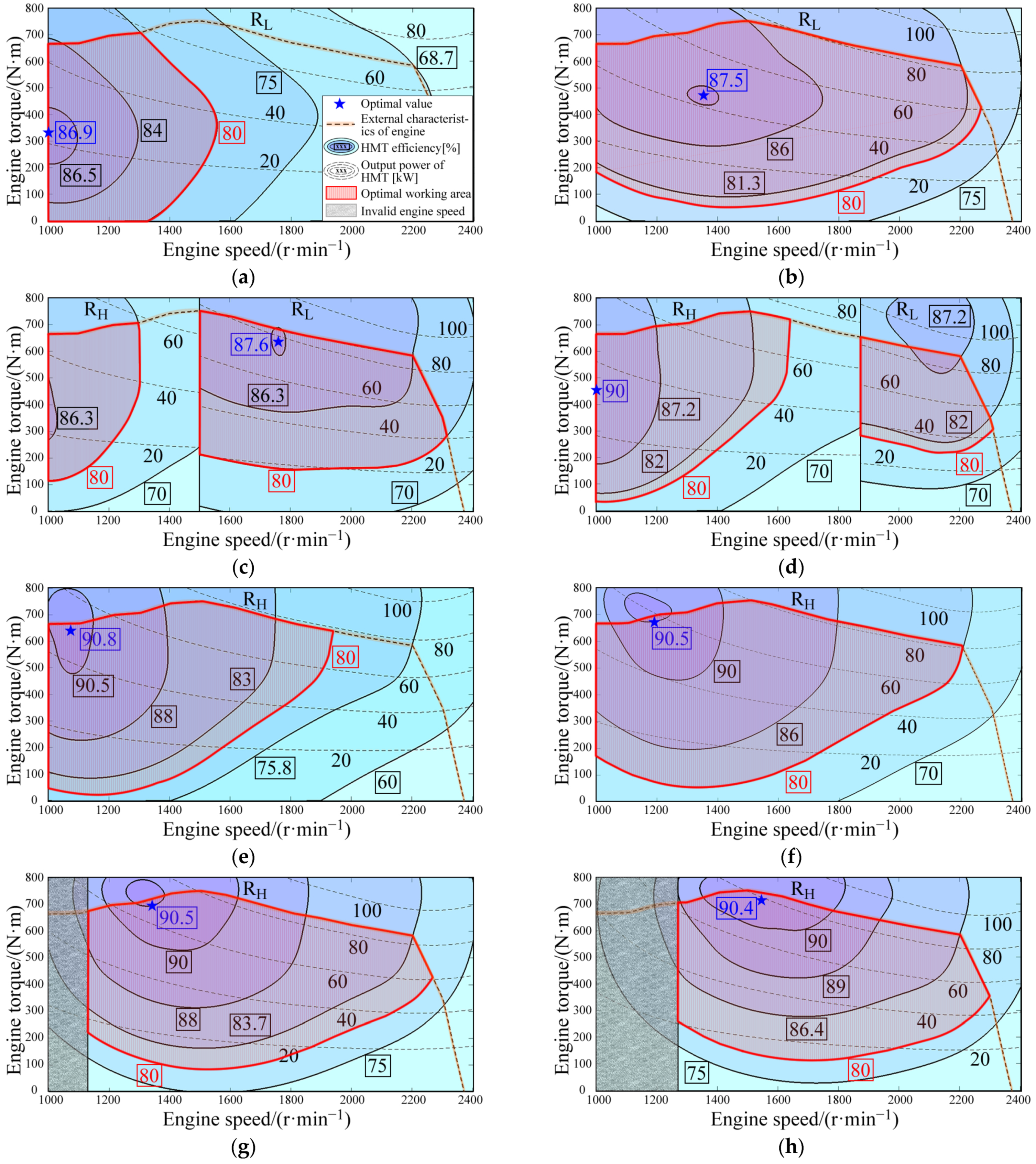

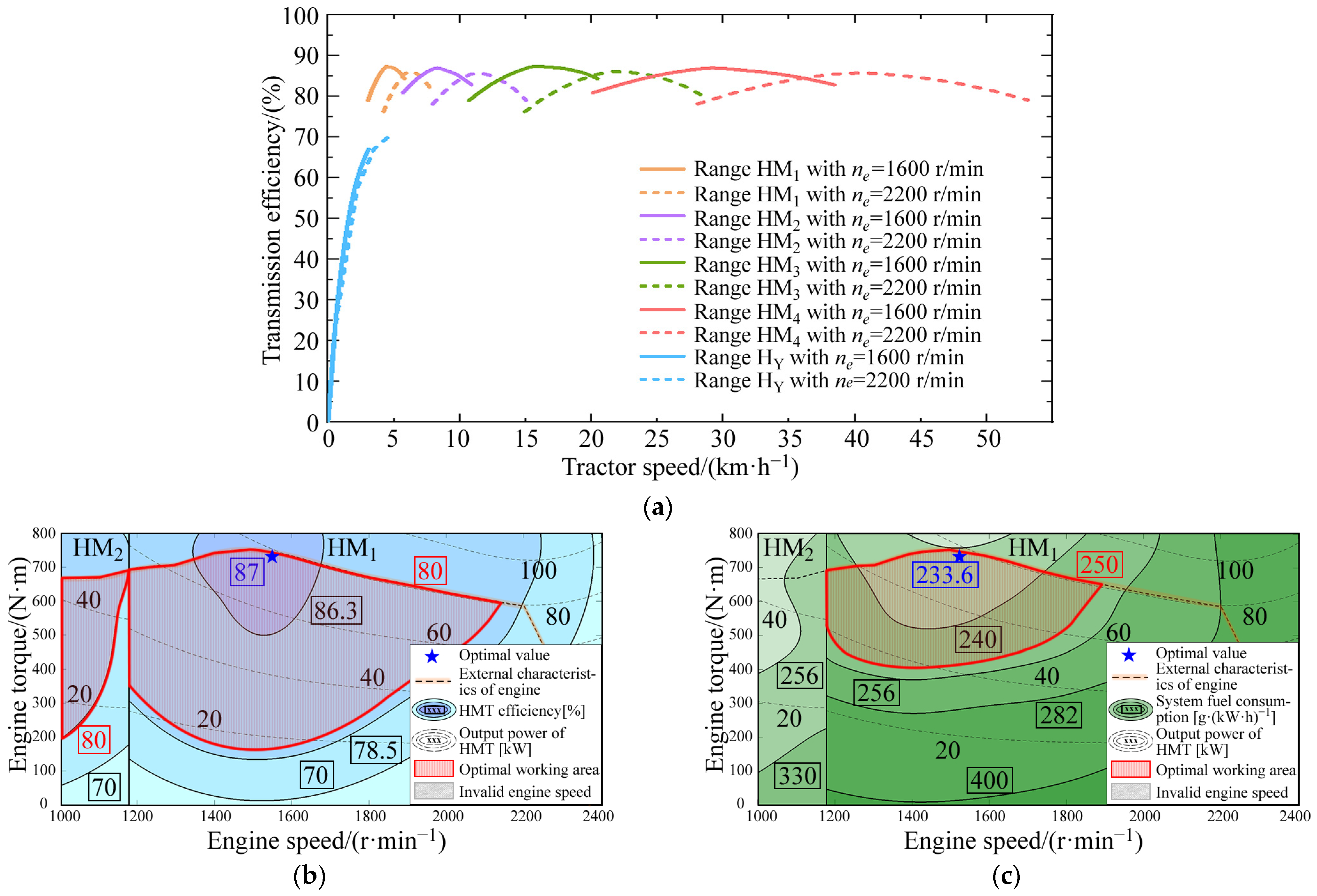
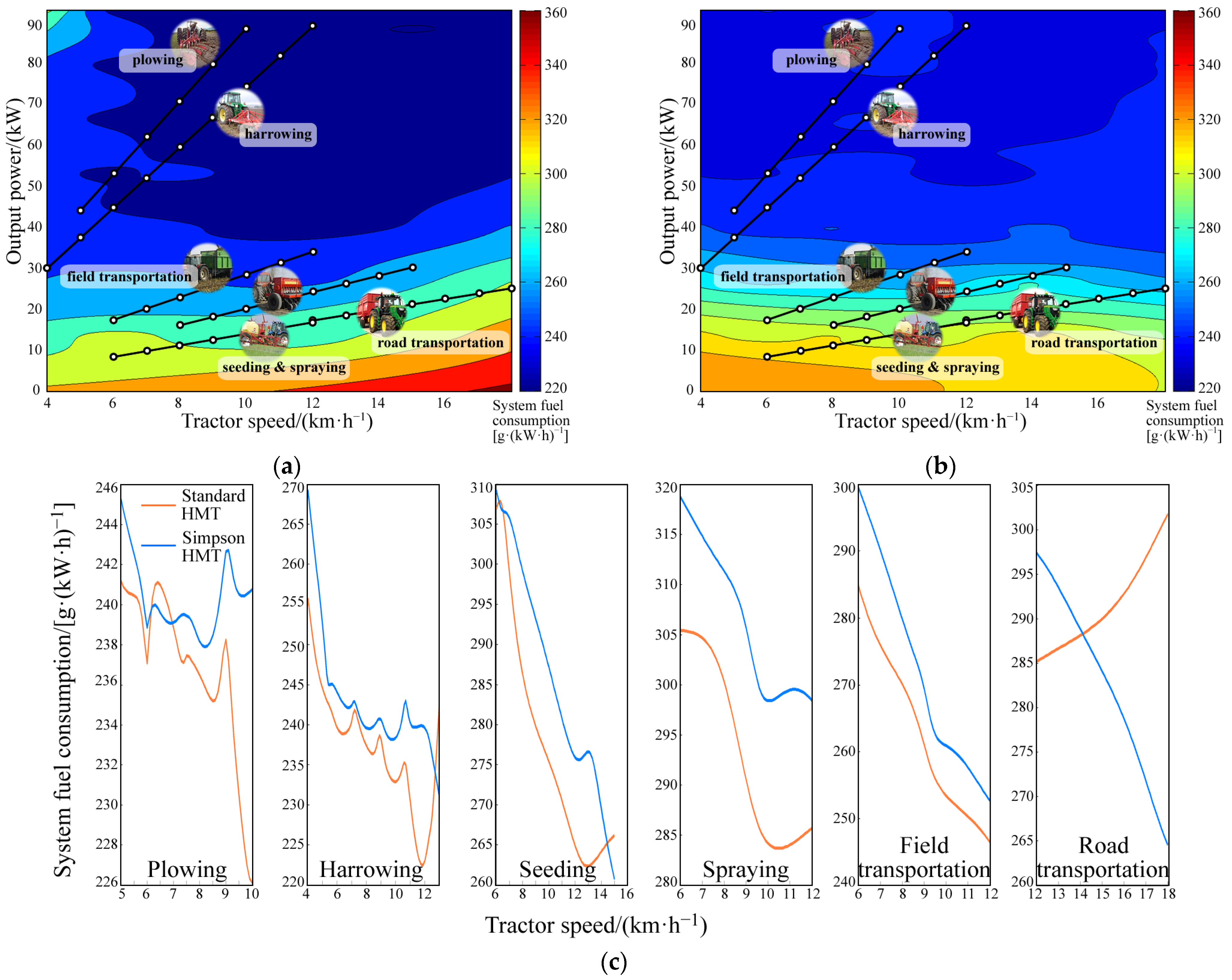

| Gear | Range | Clutch/Brake | Planetary Gear | ||||||
|---|---|---|---|---|---|---|---|---|---|
| cL | cH | cM | cN | cA | cB | K | p0 | ||
| GL | RY | ○ | ○ | ● | ○ | ● | ○ | ● | ● |
| RL | ● | ○ | ● | ○ | ● | ○ | ○ | ● | |
| RH | ○ | ● | ○ | ● | ● | ○ | ○ | ● | |
| RR | ○ | ○ | ○ | ● | ● | ○ | ● | ● | |
| GH | RY | ○ | ○ | ● | ○ | ○ | ● | ● | ● |
| RL | ● | ○ | ● | ○ | ○ | ● | ○ | ● | |
| RH | ○ | ● | ○ | ● | ○ | ● | ○ | ● | |
| RR | ○ | ○ | ○ | ● | ○ | ● | ● | ● | |
| Range | Clutch | Planetary Gear | |||||
|---|---|---|---|---|---|---|---|
| c0 | c1 | c2 | c3 | c4 | p1 | p2 | |
| HY | ● | ○ | ○ | ○ | ○ | ○ | ○ |
| HM1 | ○ | ● | ○ | ○ | ○ | ● | ○ |
| HM2 | ○ | ○ | ● | ○ | ○ | ○ | ● |
| HM3 | ○ | ○ | ○ | ● | ○ | ● | ○ |
| HM4 | ○ | ○ | ○ | ○ | ● | ○ | ● |
| Plowing | Harrowing | Seeding | Spraying | Field Transportation | Road Transportation | |
|---|---|---|---|---|---|---|
| Simpson HMT | 239.5 | 239.8 | 284 | 300.5 | 269.4 | 284.1 |
| Standard HMT | 237.5 | 236.4 | 237.1 | 290.5 | 261 | 290 |
| Relative error (%) | 0.8 | 1.4 | 16.5 | 3.3 | 3.1 | −2.1 |
Disclaimer/Publisher’s Note: The statements, opinions and data contained in all publications are solely those of the individual author(s) and contributor(s) and not of MDPI and/or the editor(s). MDPI and/or the editor(s) disclaim responsibility for any injury to people or property resulting from any ideas, methods, instructions or products referred to in the content. |
© 2023 by the authors. Licensee MDPI, Basel, Switzerland. This article is an open access article distributed under the terms and conditions of the Creative Commons Attribution (CC BY) license (https://creativecommons.org/licenses/by/4.0/).
Share and Cite
Zhao, Y.; Chen, X.; Song, Y.; Wang, G.; Zhai, Z. Energy and Fuel Consumption of a New Concept of Hydro-Mechanical Tractor Transmission. Sustainability 2023, 15, 10809. https://doi.org/10.3390/su151410809
Zhao Y, Chen X, Song Y, Wang G, Zhai Z. Energy and Fuel Consumption of a New Concept of Hydro-Mechanical Tractor Transmission. Sustainability. 2023; 15(14):10809. https://doi.org/10.3390/su151410809
Chicago/Turabian StyleZhao, Yehui, Xiaohan Chen, Yue Song, Guangming Wang, and Zhiqiang Zhai. 2023. "Energy and Fuel Consumption of a New Concept of Hydro-Mechanical Tractor Transmission" Sustainability 15, no. 14: 10809. https://doi.org/10.3390/su151410809




